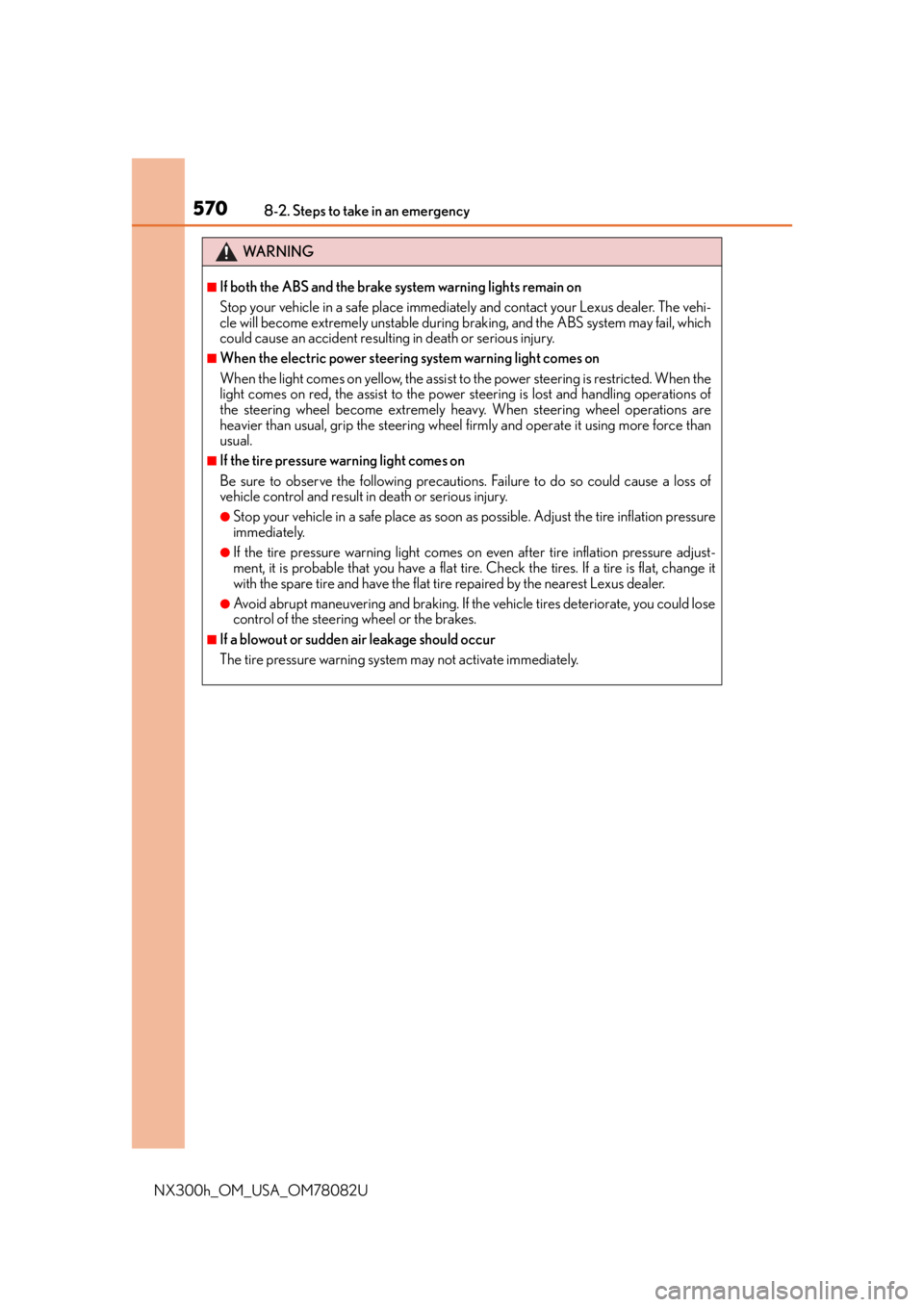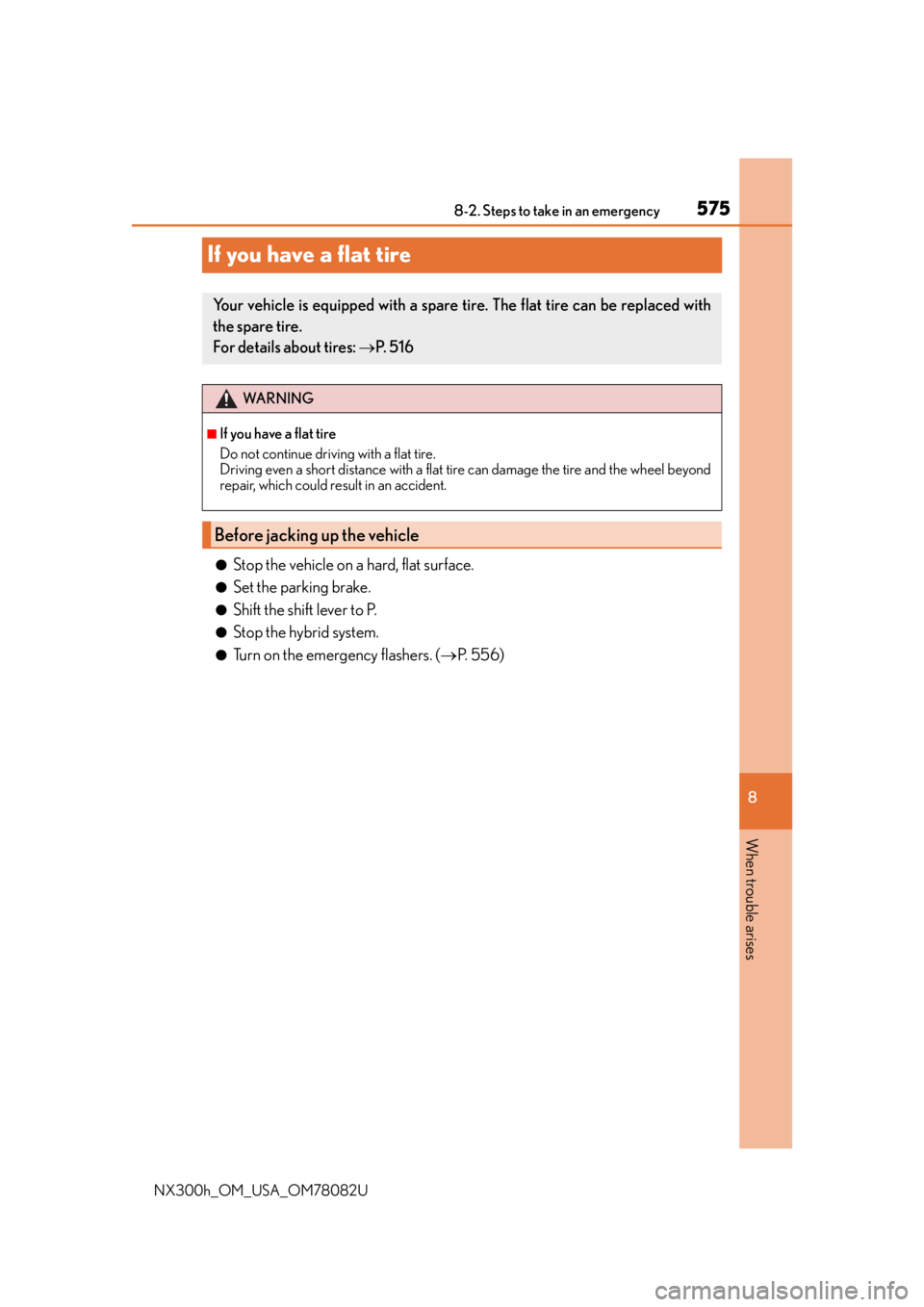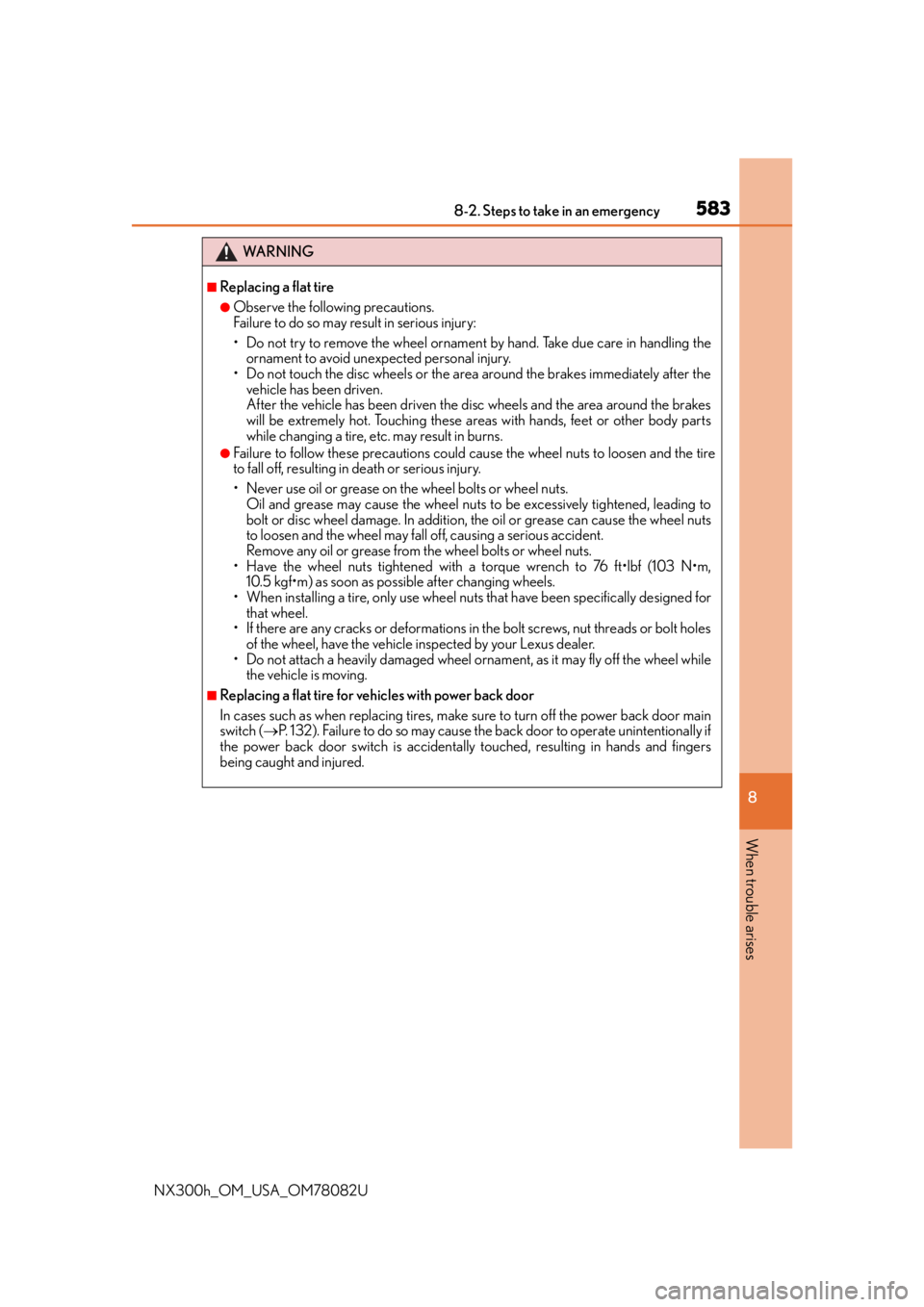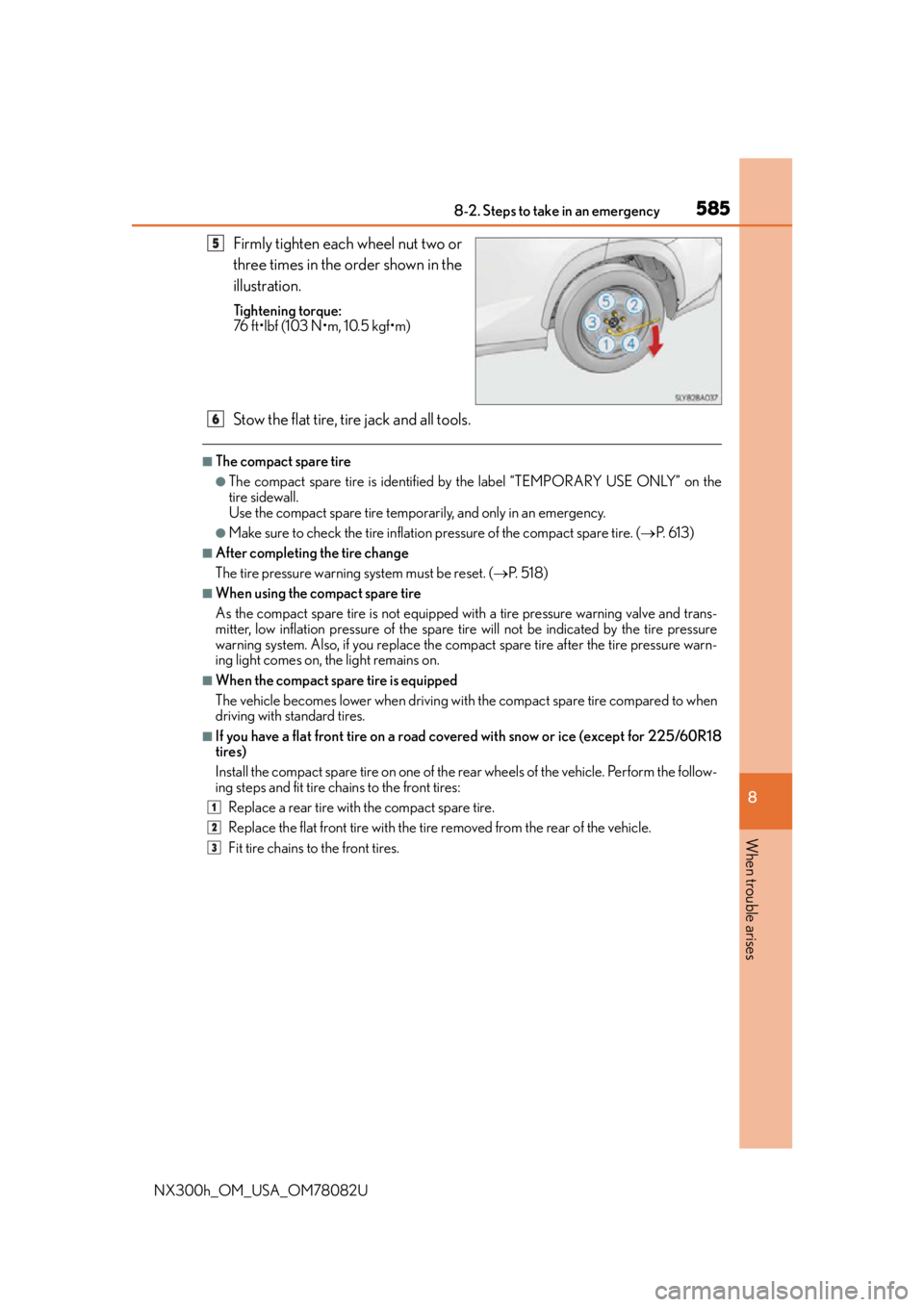flat tire LEXUS NX300H 2016 Owner's Guide
[x] Cancel search | Manufacturer: LEXUS, Model Year: 2016, Model line: NX300H, Model: LEXUS NX300H 2016Pages: 680, PDF Size: 10.23 MB
Page 567 of 680

5678-2. Steps to take in an emergency
8
When trouble arises
NX300h_OM_USA_OM78082U
Low fuel level warning lightIndicates that remaining fuel is approximately 2.2 gal. (8.4 L,
1.8 Imp.gal.) or less
Refuel the vehicle.
Driver's and front passenger's seat belt reminder light (warning
buzzer)
*2
Warns the driver and/or front passenger to fasten their seat belts
Fasten the seat belt.
If the front passenger’s seat is occupied, the front passenger’s
seat belt also needs to be fa stened to make the warning light
(warning buzzer) turn off.
Master warning light A buzzer sounds and the warning light comes on and flashes to
indicate that the master warning system has detected a malfunc-
tion.
P. 5 7 2
Tire pressure warning light
When the light comes on:
Low tire inflation pressure such as
• Natural causes ( P. 5 6 9 )
•Flat tire ( P. 5 7 5 )
Adjust the tire inflation pressure to the specified level.
The light will turn off after a fe w minutes. In case the light does
not turn off even if the tire inflation pressure is adjusted, have the
system checked by your Lexus dealer.
When the light comes on after blinking for 1 minute:
Malfunction in the tire pr essure warning system (P. 5 6 9 )
Have the system checked by your Lexus dealer.
*1
Brake Override System/Drive-Start Control warning light
Indicates that:
• The Brake Override System is operating;
• The Brake Override System is malfunctioning (with warning
buzzer);
• The Drive-Start Control is operating (with warning buzzer); or
• The Drive-Start Control is malfunctioning (with warning buzzer)
Follow the instruction that are displayed on the multi-informa-
tion display.
Warning lightWarning light/Details/Actions
Page 569 of 680

5698-2. Steps to take in an emergency
8
When trouble arises
NX300h_OM_USA_OM78082U
■When the tire pressure warning light comes on
Inspect the appearance of the tire to check that the tire is not punctured.
If the tire is punctured: P. 5 7 5
If the tire is not punctured:
Carry out the following procedure after the tire temperature has lowered sufficiently.
●Check the tire inflation pressure and adjust to the appropriate level.
●If the warning light does not go out even after several minutes, check that the tire infla-
tion pressure is at the specified level and carry out initialization. ( P. 5 1 8 )
The warning light may come on again if the above operations are conducted without first
allowing the tire temperature to lower sufficiently.
■The tire pressure warning light may come on due to natural causes
The tire pressure warning light may come on due to natural causes such as natural air
leaks and tire inflation pressure changes caused by temperature. In this case, adjusting
the tire inflation pressure will turn off the warning light (after a few minutes).
■When a tire is replaced with a spare tire
Vehicles with a compact spare tire: The comp act spare tire is not equipped with a tire
pressure warning valve and transmitter. If a tire goes flat, the tire pressure warning light
will not turn off even though the flat tire ha s been replaced with the spare tire. Replace
the spare tire with the repaired tire and adjust the tire inflation pressure. The tire pressure
warning light will go off after a few minutes.
Vehicles with a full-size spare tire: The spare tire is also equipped with a tire pressure
warning valve and transmitter. The tire pressure warning light will turn on if the tire infla-
tion pressure of the spare tire is low. If a tire goes flat, the tire pressure warning light will
not turn off even though the flat tire has been replaced with the spare tire. Replace the
spare tire with the repaired tire and adjust the tire inflation pressure. The tire pressure
warning light will go off after a few minutes.
■Conditions that the tire pressure warning system may not function properly
P. 5 2 1
■If the tire pressure warning light frequently comes on after blinking for 1 minute
If the tire pressure warning light frequently comes on after blinking for 1 minute when the
power switch is turned to ON mode, ha ve it checked by your Lexus dealer.
■Warning buzzer
In some cases, the buzzer may not be heard due to being in a noisy location or audio
sound.
Page 570 of 680

5708-2. Steps to take in an emergency
NX300h_OM_USA_OM78082U
WA R N I N G
■If both the ABS and the brake system warning lights remain on
Stop your vehicle in a safe place immediately and contact your Lexus dealer. The vehi-
cle will become extremely unstable during braking, and the ABS system may fail, which
could cause an accident resulting in death or serious injury.
■When the electric power steering system warning light comes on
When the light comes on yellow, the assist to the power steering is restricted. When the
light comes on red, the assist to the power steering is lost and handling operations of
the steering wheel become extremely heavy. When steering wheel operations are
heavier than usual, grip the steering wheel firmly and operate it using more force than
usual.
■If the tire pressure warning light comes on
Be sure to observe the following precautions. Failure to do so could cause a loss of
vehicle control and result in death or serious injury.
●Stop your vehicle in a safe place as soon as possible. Adjust the tire inflation pressure
immediately.
●If the tire pressure warning light comes on even after tire inflation pressure adjust-
ment, it is probable that you have a flat tire. Check the tires. If a tire is flat, change it
with the spare tire and have the flat tire repaired by the nearest Lexus dealer.
●Avoid abrupt maneuvering and braking. If the vehicle tires deteriorate, you could lose
control of the steering wheel or the brakes.
■If a blowout or sudden air leakage should occur
The tire pressure warning system may not activate immediately.
Page 571 of 680

5718-2. Steps to take in an emergency
8
When trouble arises
NX300h_OM_USA_OM78082U
WA R N I N G
■Maintenance of the tires
Each tire, including the spare (if provided), should be checked monthly when cold and
inflated to the inflation pressure recomm ended by the vehicle manufacturer on the
vehicle placard or tire inflation pressure la bel (tire and load information label). (If your
vehicle has tires of a different size than the size indicated on the vehicle placard or tire
inflation pressure label [tire and load in formation label], you should determine the
proper tire inflation pressure for those tires.)
As an added safety feature, your vehicle has been equipped with a tire pressure moni-
toring system (TPMS-tire pressure warning system) that illuminates a low tire pressure
telltale (tire pressure warning light) when on e or more of your tires is significantly
under-inflated. Accordingly, when the low ti re pressure telltale (tire pressure warning
light) illuminates, you should stop and check your tires as soon as possible, and inflate
them to the proper pressure. Driving on a significantly under-inflated tire causes the
tire to overheat and can lead to tire failure. Under-inflation also reduces fuel efficiency
and tire tread life, and ma y affect the vehicle’s handling and stopping ability.
Please note that the TPMS (tire pressure wa rning system) is not a substitute for proper
tire maintenance, and it is the driver’s resp onsibility to maintain correct tire pressure,
even if under-inflation has no t reached the level to trigger illumination of the TPMS low
tire pressure telltale (tire pressure warning light).
Your vehicle has also been equipped with a TPMS (tire pressure warning system) mal-
function indicator to indicate when the system is not operating properly. The TPMS
(tire pressure warning system) malfunction indi cator is combined with the low tire pres-
sure telltale (tire pressure warning light). When the system detects a malfunction, the
telltale will flash for approximately one minu te and then remain continuously illumi-
nated. This sequence will cont inue upon subsequent vehicle start-ups as long as the
malfunction exists. When the malfunction indicator is illuminated, the system may not
be able to detect or signal low tire pressure as intended.
TPMS (tire pressure warning system) malfun ctions may occur for a variety of reasons,
including the installation of replacement or alternate tires or wheels on the vehicle that
prevent the TPMS (tire pressure warning system) from functioning properly. Always
check the TPMS (tire pressure warning syst em) malfunction telltale after replacing one
or more tires or wheels on your vehicle to ensure that the replacement or alternate
tires and wheels allow the TPMS (tire pressure warning system) to continue to function
properly.
NOTICE
■To ensure the tire pressure warning system operates properly
Do not install tires with different specificatio ns or makers, as the tire pressure warning
system may not operate properly.
Page 575 of 680

575
8
When trouble arises
8-2. Steps to take in an emergency
NX300h_OM_USA_OM78082U
If you have a flat tire
●Stop the vehicle on a hard, flat surface.
●Set the parking brake.
●Shift the shift lever to P.
●Stop the hybrid system.
●Turn on the emergency flashers. ( P. 5 5 6 )
Your vehicle is equipped with a spare ti re. The flat tire can be replaced with
the spare tire.
For details about tires: P. 5 1 6
WA R N I N G
■If you have a flat tire
Do not continue driving with a flat tire.
Driving even a short distance with a flat ti re can damage the tire and the wheel beyond
repair, which could result in an accident.
Before jacking up the vehicle
Page 577 of 680

5778-2. Steps to take in an emergency
8
When trouble arises
NX300h_OM_USA_OM78082U
WA R N I N G
■Using the tire jack
Observe the following precautions.
Improper use of the tire jack may cause the vehicle to suddenly fall off the jack, leading
to death or serious injury.
●Do not use the tire jack for any purpose ot her than replacing tires or installing and
removing tire chains.
●Only use the tire jack that comes with this vehicle for replacing a flat tire.
Do not use it on other vehicles, and do not use other tire jacks for replacing tires on
this vehicle.
●Put the jack properly in its jack point.
●Do not put any part of your body under the vehicle while it is supported by the jack.
●Do not start the hybrid system or drive the vehicle while the vehicle is supported by
the jack.
●Do not raise the vehicle while someone is inside.
●When raising the vehicle, do not put an object on or under the jack.
●Do not raise the vehicle to a height greater than that required to replace the tire.
●Use a jack stand if it is necessary to get under the vehicle.
●When lowering the vehicle, make sure that there is no-one near the vehicle. If there
are people nearby, warn them vocally before lowering.
Page 581 of 680

5818-2. Steps to take in an emergency
8
When trouble arises
NX300h_OM_USA_OM78082U
Chock the tires.
Slightly loosen the wheel nuts (one
turn).
Turn the tire jack portion by hand
until the notch of the jack is in con-
tact with the jack point.
The jack point guides are located under
the rocker panel. They indicate the jack
point positions.
Replacing a flat tire
1
Flat tireWheel chock positions
FrontLeft-hand sideBehind the rear right-hand side tire
Right-hand sideBehind the rear left-hand side tire
RearLeft-hand sideIn front of the front right-hand side tire
Right-hand sideIn front of the front left-hand side tire
2
3A
Page 583 of 680

5838-2. Steps to take in an emergency
8
When trouble arises
NX300h_OM_USA_OM78082U
WA R N I N G
■Replacing a flat tire
●Observe the following precautions.
Failure to do so may result in serious injury:
• Do not try to remove the wheel ornament by hand. Take due care in handling the
ornament to avoid unexpected personal injury.
• Do not touch the disc wheels or the area around the brakes immediately after the vehicle has been driven.
After the vehicle has been driven the disc wheels and the area around the brakes
will be extremely hot. Touching these areas with hands, feet or other body parts
while changing a tire, etc. may result in burns.
●Failure to follow these precautions could cause the wheel nuts to loosen and the tire
to fall off, resulting in death or serious injury.
• Never use oil or grease on the wheel bolts or wheel nuts.
Oil and grease may cause the wheel nuts to be excessively tightened, leading to
bolt or disc wheel damage. In addition, the oil or grease can cause the wheel nuts
to loosen and the wheel may fall off, causing a serious accident.
Remove any oil or grease from the wheel bolts or wheel nuts.
• Have the wheel nuts tightened with a torque wrench to 76 ft•lbf (103 N•m, 10.5 kgf•m) as soon as possible after changing wheels.
• When installing a tire, only use wheel nuts that have been specifically designed for
that wheel.
• If there are any cracks or deformations in the bolt screws, nut threads or bolt holes
of the wheel, have the vehicle inspected by your Lexus dealer.
• Do not attach a heavily damaged wheel ornament, as it may fly off the wheel while
the vehicle is moving.
■Replacing a flat tire for vehicles with power back door
In cases such as when replacing tires, make sure to turn off the power back door main
switch ( P. 132). Failure to do so may cause the back door to operate unintentionally if
the power back door switch is accidentally touched, resulting in hands and fingers
being caught and injured.
Page 585 of 680

5858-2. Steps to take in an emergency
8
When trouble arises
NX300h_OM_USA_OM78082U
Firmly tighten each wheel nut two or
three times in the order shown in the
illustration.
Tightening torque:
76 ft•lbf (103 N•m, 10.5 kgf•m)
Stow the flat tire, tire jack and all tools.
■The compact spare tire
●The compact spare tire is identified by the label “TEMPORARY USE ONLY” on the
tire sidewall.
Use the compact spare tire temporarily, and only in an emergency.
●Make sure to check the tire inflation pressure of the compact spare tire. ( P. 6 1 3 )
■After completing the tire change
The tire pressure warning system must be reset. ( P. 5 1 8 )
■When using the compact spare tire
As the compact spare tire is not equipped wi th a tire pressure warning valve and trans-
mitter, low inflation pressure of the spare ti re will not be indicated by the tire pressure
warning system. Also, if you replace the compact spare tire after the tire pressure warn-
ing light comes on, th e light remains on.
■When the compact spare tire is equipped
The vehicle becomes lower when driving with the compact spare tire compared to when
driving with standard tires.
■If you have a flat front tire on a road covered with snow or ice (except for 225/60R18
tires)
Install the compact spare tire on one of the rear wheels of the vehicle. Perform the follow-
ing steps and fit tire chains to the front tires:
Replace a rear tire with the compact spare tire.
Replace the flat front tire with the tire removed from the rear of the vehicle.
Fit tire chains to the front tires.
5
6
1
2
3
Page 613 of 680

6139-1. Specifications
9
Vehicle specifications
NX300h_OM_USA_OM78082U
Ty p e A
Ty p e B
Steering
Free playLess than 1.2 in. (30 mm)
Tires and wheels
Ti r e s i z e225/65R17 102H
Tire inflation pressure
(Recommended cold tire
inflation pressure)
Driving under normal conditions
Front
35 psi (240 kPa, 2.4 kgf/cm2 or bar)
Rear
35 psi (240 kPa, 2.4 kgf/cm2 or bar)Driving at high speeds (above 100 mph [160 km/h])
(in countries where such speeds are permitted by
law)
Add 1 psi (10 kPa, 0.1 kgf/cm2 or bar) to the front
and rear tires. Never exceed the maximum cold
tire inflation pressure in dicated on the tire side-
wall.
Wheel size17 7 J
Wheel nut torque76 ft•lbf (103 N•m, 10.5 kgf•m)
Ti r e s i z e225/60R18 100H
Tire inflation pressure
(Recommended cold tire
inflation pressure)
Driving under normal conditions
Front
32 psi (220 kPa, 2.2 kgf/cm2 or bar)
Rear
32 psi (220 kPa, 2.2 kgf/cm2 or bar)
Driving at high speeds (above 100 mph [160 km/h])
(in countries where such speeds are permitted by
law)
Add 9 psi (60 kPa, 0.6 kgf/cm2 or bar) to the
front and rear tires. Never exceed the maximum
cold tire inflation pressure indicated on the tire
sidewall.
Wheel size18 7 1 /2 J
Wheel nut torque76 ft•lbf (103 N•m, 10.5 kgf•m)